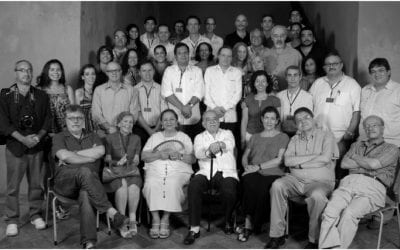Mexico’s Indigenous Communities: Their Lands and Histories, 1500-2010
Spring/Summer 2011, Volume X, Number 2

Mexico’s Indigenous Communities: Their Lands and Histories, 1500-2010, by Ethelia Ruiz Medrano (University Press of Colorado, 2010 ).
Mexico’s Indigenous Communities: Their Lands and Histories, 1500-2010 lives up to its ambitious title. In only 291 pages of dense near-encyclopedic history, Ruiz Medrano orders an enormous corpus of facts and arguments to provide a Post-Conquest review of indigenous land loss and imaginative efforts to control it. The lengthy bibliography includes original findings from Seville’s Archive of the Indies, builds on major writers on Mexico’s social and economic history, cites comparative cases from other part of Latin America, and the details the author’s ethnographic research of contemporary land struggles in Guerrero and Oaxaca. The text does not engage the reader in an “easy read,” but rather, provides a reference work that will be useful for years to come.
Running through this history are two threads. One is the persistent indigenous effort to engage Spanish and, later Mexican, authorities in negotiations over land and principles of land rights. Here the author’s emphasis lies in interactive indigenous agency with State agencies, not simple resistance and certainly not passive acquiescence. As the 510 year history progresses, the Indians, of course, lose nearly all of their land and most control over its resources. However, the period is punctuated by dignified arguments substantiated by primordial land claims. The manner of this indigenous argument—primordial evidence expressed symbolically and visually—is the book’s second thread. The Pueblos use codices, maps, and other symbolic visual devices, in many cases obtained by the author, that serve, as Ruiz Medrano consistently emphasizes, to “negotiate” land rights with local authorities and the Crown.
These are not simple reactions or spontaneous protests, but patterned exercises of agency to demonstrate land claims. The Indians did, after all, lose most of their lands, but the book illustrates an imaginative flow of persistent legal actions and changing concepts of law. While the author appropriately lays the blame for land losses on the locus of power—Spanish and, later, Mexican governments—the text is pleasantly free of blame on the current bête noir—neoliberalism— which has replaced “dependency theory” as the “explain all” that often masks the complex interrelations and understandings that provide a modicum of indigenous agency.
The first two chapters review legal and land tenure history of the 16th to 18th centuries. They provide a detailed review of, on the one hand, a “clash of civilizations” in which, at least from the perspective of the Spanish Crown, there is basic respect, illustrated by complex legal arrangements created to order relationships. Likewise, we see arguments accepted and based on indigenous history and geography, as illustrated by the complex codices (which would be far more impressive if the original colors had been printed). However much the negations are imbalanced by the Christians’ invocation of God-given powers through such tools as Papal Bulls, there is a sense that, at the highest levels diplomacy as well as power is at work. On the other, somewhat more soiled, hand, local level Spanish behavior was a simple series of efforts to increase personal wealth, exploit indigenous labor, and obtain permanent land holdings. It is easily and cynically argued that the Crown’s relatively benevolent behavior was little more than an effort to weaken the increasing powers of the colonial elites. With that in mind, the book could have been improved through more discussion of the many legal and philosophical debates that took place in Spain during this period. Nonetheless, Ruiz Medrano presents the progressive demise of formal Colonial land rights in a manner that parallels Charles Gibson’s classic study “The Aztecs Under Spanish Rule” while taking the reader far closer into specific cases and, again, showing how communities continued to document individual cases through the ingenious use of dramatic codices and maps as evidence.
The Colonial period introduced diseases that may have been the most devastating to Mexico’s indigenous population, but Ruiz Medrano’s next chapter shows that the revolutionary and liberal 19th century was perhaps the most destructive to the social fiber and lands that held that cloth together. Much of what occurred was seen as liberating the Indian from his childlike protected status. Though realized in a somewhat schizophrenic and on/off manner, the Pueblos were provided with opportunities for local governance and a degree of local legal control. But Ruiz Medrano emphasizes that “…as a result of legislation passed first by the Cadiz Cortes government and then by successive liberal and conservative national governments, [the Indians] lost the protection the monarchy had given them by virtue of their special juridical status. With the abolition of a special Indian court, the Indians were henceforth placed on the same legal footing as other social and ethnic groups, divested of the protection of a “paternalistic” monarchy—however much such protection would have been confined to the realm of legislation.” 19th century Indians were now independent “citizens,” not subjects clustered in communities. But while they could no longer be thrown to the lions, they were left relatively unarmed to face the wolves. Again Ruiz Medrano chronicles imaginative efforts to overcome that weakness, but the outcome proves little substantive indigenous self-determination in arenas such as land and land rights.
The most insidious freedom of the 19th century granted to the Pueblos was the freedom from themselves, particularly with regard to what was seen as suffocating and anachronistic customs of land tenure. Communal lands, with their inability to alienate individual plots, were inconsistent with the liberal Enlightenment notions of freedom to “improve” ones individual self. So communal lands are provided with legal mechanisms whereby individuals can convert usufruct holdings into private properties. As with the US Dawes Act of that time, the individual acquired not simply his own lands, but he would help to break up his neighbors’ lands as well. The idea that such new freedoms could be used simply to shift lands to non-indigenous peoples was certainly not lost on the Pueblos, and Ruiz Medrano’s long review of their efforts to retain Ejidos is testimony to indigenous resourcefulness. The final chapter reviews two cases—one from Guerrero and another from Oaxaca. Each features a strong local indigenous figure that draws on history and visual imagery to inspire local citizens.
What comes across in this richly detailed book is the sense that while great losses have occurred, they have not come at the price of indigenous dignity nor the destruction of the many arguments made though careful manipulation of indigenous symbols. As such, the symbols are useful negotiating tools as well as a mirror onto which indigenous peoples project a sense of sense of self and history.
Theodore Macdonald is a Fellow at the University Committee on Human Rights Studies, and a Lecturer in Social Studies at Harvard University. In 2009, he co-edited the volume Manifest Destinies and Indigenous Peoples (DRCLAS/Harvard University Press). He also undertook the ethnographic research and subsequently served as witness for the plaintiff in the precedent-setting 2001 indigenous land and natural resource rights case, Awas Tingni vs. Nicaragua, heard, and determined in favor of the community, before the Inter-American Court of Human Rights.
Related Articles
New Journalists for a New World
I received a surprising phone call one day in late 1993, when I was the director of Telecaribe, a public television channel in Barranquilla, Colombia. The caller was none other than Gabriel García Márquez. “Will you invite me to dinner?” he asked me. “Of course, Gabito,” I…
Latin American Nieman Fellows
A few days after I arrived at Harvard in August 2000 to begin my work as curator of the Nieman Foundation for Journalism, Tim Golden, an investigative reporter for the New York Times in Latin America, phoned me. “Could I find a place in the new Nieman class for a Colombian…
Freedom of Expression in Latin America
In June 1997, Chile’s Supreme Court upheld a ban on the film “The Last Temptation of Christ,” based on a Pinochet-era provision of the country’s constitution. Four years later, the Inter-American Court of Human Rights heard a challenge to this ban and issued a very different…




